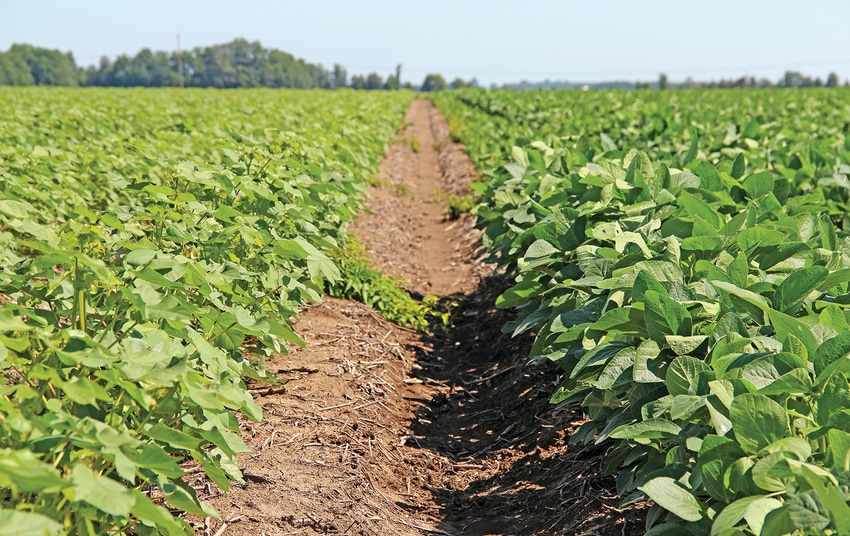
Thousands of acres of soybeans in eastern Arkansas are under attack from a tiny pest against which they have little or no natural defenses, said John Rupe, professor of plant pathology for the University of Arkansas System Division of Agriculture.
Root knot nematodes are plant parasitic round worms that are so small they are measured in micrometers. They attack the plants at the roots where they cause swellings called “galls.”
Those galls bind up a lot of the plant’s energy, in the form of sugars, that otherwise would be used for plant growth and development. They also disrupt the movement of water and nutrients through the roots. The result for soybean producers, Rupe said, is a dramatic loss of crop yield.
Rupe said root knot nematodes can thrive on hundreds of plant hosts and are common in sandy soils once used primarily for cotton production. Changes in crop prices in recent years have led to a lot of cotton acres being converted to other crops, he said, and a lot of those acres are now planted with soybeans.
“Cotton is a good host for root knot nematode,” Rupe said, “and they like coarse, loose soils like the sandy soils in many areas of east Arkansas and neighboring areas of Mississippi and Louisiana.”
Rapid Research Response
To attack the problem of potential economic loss, Rupe obtained a USDA Critical Agricultural Research and Extension grant. Also known as CARE, the grants are designed to fund research in areas of immediate need when existing research leading to a solution is lacking.
As principle investigator, Rupe coordinated a research effort of scientists from the U of A Division of Agriculture, Mississippi State University and Louisiana State University. The researchers’ areas of expertise included plant pathology and nematology, soil science and agricultural economics.
The research drew on existing research data and employed the latest technology and time-tested scientific methodology to test nematode control strategies on cooperating farms in all three states, Rupe said. They used replicated test strips in soybean fields, including control strips in which no control strategy was used.
“There are no high-yield soybean varieties with good resistance to root knot nematode,” Rupe said. “So we focused on nematicide soil applications and seed treatments.”
Crop rotation was not tested, Rupe said, because root knot nematodes thrive in such a wide range of plant hosts that there are few options among rotation crops that would help reduce the pest populations.
“Peanuts make a good rotation crop to control these nematodes,” Rupe said, “but peanuts are not a practical option for most farmers.”
Nematicide
The research has shown that the most effective control strategy for root knot nematodes is a nematicide chemical called Telone II. It’s a preplant fumigant that must be injected into the soil about two weeks before planting, Rupe said.
“Telone II provides effective control,” he said, “but it’s expensive.”
Division of Agriculture economist Robert Stark, based at the Southeast Research and Extension Center at Monticello, Ark., is working out the economics of cost versus return, Rupe said, and those numbers will figure into recommendations the division is developing for soybean growers.
In the meantime, Arkansas’ highly variable soil structures, especially in the Delta, offer cost-cutting potential, Rupe said.
Land within a single field can vary from sandy soils to more densly packed silt loams and clays, where nematode populations are lower or even nonexistent, Rupe said.
“We wanted to know if spot applications based on soil texture would offer sufficient control of root knot nematode,” Rupe said.
Soil structure in test fields was analyzed and mapped using electrical conductivity sensors from Veris Technologies, Rupe said. Finer, more compacted soils conduct electricity more efficiently than coarser, looser sandy soils. The soil texture maps generated by this system identify sandy areas in a field where root knot nematodes occur in higher populations.
Evaluating Results
Results of the test applications were evaluated by digital image analysis from drones, satellites and yield monitors on combines during harvest.
Tests in which Telone II was applied only in the sandy areas indicated that soil texture-guided spot applications provided good protection against root knot nematodes.
Seed treatments offer good protection in areas where root knot nematode populations are light, Rupe said. The protection is limited because seed treatments offer protection for relatively short periods after planting.
Rupe said the research results are being disseminated through scientific and producers meetings and presentations at agricultural research field days. Once useful recommendations have been developed, they will be disseminated through county Extension agents in the partner states.
In the meantime, an animated video has been produced to explain and illustrate the research. It will be shown at meetings and is available online: https://youtu.be/F3gTMUnBlwQ.
About the Author(s)
You May Also Like






